Deep Space Robotics Market Research, 2033
The global Deep Space Robotics Market Size was valued at $1564 million in 2023, and is projected to reach $3329.1 million by 2033, growing at a CAGR of 8.2% from 2024 to 2033.
Space robots are self-controlled devices consisting of mechanical, electrical, and electronic components that function in place of a living agent. Space robots survive harsh environment of space and perform functions such as construction, maintenance, exploration, and servicing of spatial satellites. The space robotics industry is achieving high Deep Space Robotics Market Growth due to its benefits such as better productivity, cost effectiveness, and the ability to perform in harsh situations as a human substitute. Space robots are expected to carry out the future of deep space exploration.
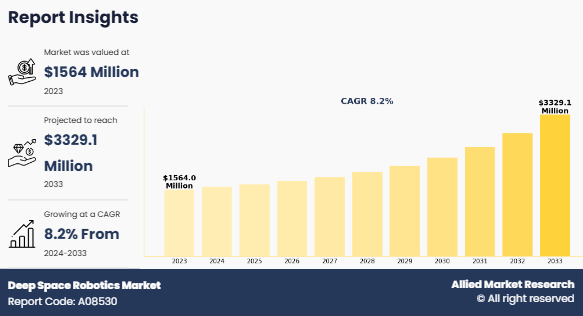
Key Takeaways
- The Deep Space Robotics Market Share covers 20 countries. The research includes a segment analysis of each country in terms of value ($Billion) for the projected period 2023-2033.
- More than 1,500 product literatures, industry releases, annual reports, and other such documents of major decorative coatings industry participants along with authentic industry journals, trade associations' releases, and government websites have been reviewed for generating high-value industry insights.
- The study integrated high-quality data, professional opinions and analysis, and critical independent perspectives. The research approach is intended to provide a balanced view of global markets and to assist stakeholders in making educated decisions to achieve their most ambitious growth objectives.
Factors such as increase in investments for space robotics across the globe, rise in demand for satellite launches, and surge in number of joint ventures by key players to expand business and geographic reach drive the growth of the space robotics market. Moreover, factors such as excessive costs involved in space robotics & space exploration missions and increase in the amount of debris in the space orbit restrain the growth of space robotics market. Furthermore, factors such as technological upgrades in space industry and use of software defined technology in space robots for flexibility to alter space missions are expected to create lucrative opportunities for leading players of space robotics products operating in the market.
Increase in complexity and ambition of deep space exploration missions boost the Deep Space Robotics Market Demand for advanced robotics. Governments and private entities invest heavily in missions to the Moon, Mars, and beyond, requiring robots for tasks such as planetary surface exploration, sample collection, and infrastructure construction. These robots must operate autonomously in harsh, unpredictable environments, pushing innovation in AI, machine learning, and robotic mobility. For instance, NASA's Artemis program and ESA's lunar initiatives rely on robotic systems for lunar landings and habitat construction. In addition, the growing interest in asteroid mining and deep space resource utilization further fuels the need for specialized robotics. As missions extend farther into space, the reliance on robots for tasks too dangerous or impractical for humans is expected to continue to grow, making robotics a cornerstone of deep space exploration.
In addition, breakthroughs in robotics and artificial intelligence significantly propel the deep space robotics market expansion. Modern robots are equipped with advanced sensors, high-precision actuators, and AI algorithms that enable autonomous decision-making and adaptability in unknown environments. Innovations such as swarm robotics, where multiple robots collaborate, are enhancing mission efficiency and redundancy. In addition, improvements in materials science are leading to lighter, more durable robots capable of withstanding extreme space conditions. AI-driven systems allow robots to process vast amounts of data in real-time, enabling tasks such as navigation, obstacle avoidance, and scientific analysis without human intervention. Companies and research institutions are also developing human-robot interaction technologies, allowing astronauts to control robots remotely. These technological advancements are reducing mission costs and risks, making deep space exploration more feasible and accelerating the adoption of robotics in the sector.
Recent innovations in artificial intelligence (AI) and robotics are revolutionizing space exploration. AI algorithms have enhanced the decision-making speed and accuracy of space robots, enabling them to process vast amounts of data in real-time and make autonomous decisions in complex environments. Innovations in robotics hardware have led to the development of more robust and flexible robots capable of withstanding the extreme conditions of space. Integrating AI with emerging technologies like quantum computing is poised to transform space robotics, offering the potential for exponentially faster data processing and more informed decision-making during exploration missions.
However, the market faces challenges, such as high development and operational costs, technological complexities, and the need for robust systems capable of operating autonomously in unpredictable environments. The development and deployment of deep space robotics systems involve significant costs, with research and development, manufacturing, testing, and maintenance of space-worthy robotic systems requiring substantial investments. In addition, operating in the extreme conditions of space presents technical challenges, such as radiation, extreme temperatures, vacuum, and limited communication bandwidth. Overcoming these challenges requires advanced engineering and robust designs.
Despite these challenges, the deep space robotics market offers several opportunities for innovation. The increasing interest in asteroid mining for valuable resources, such as precious metals and rare earth elements, creates opportunities for robotic systems to conduct mining operations in space. Robots can be used to extract and process resources from asteroids, reducing the dependence on Earth finite resources. In addition, the growing number of satellites in orbit requires maintenance, repairs, and upgrades. Robotic systems are used for satellite servicing tasks, including refueling, repair, and deorbiting. This market segment presents significant growth opportunities for deep space robotics.
The deep space robotics market is segmented on the basis of solution, application, end user, and region. On the basis of solution, it is divided into remotely operated vehicles, remote manipulator system, software, and services. On the basis of application, it is classified into exploration missions, satellite servicing, and space infrastructure assembly. On the basis of end user, it is bifurcated into commercial and government. On the basis of region, the market is analyzed across North America, Europe, Asia-Pacific, and LAMEA.
By Solution
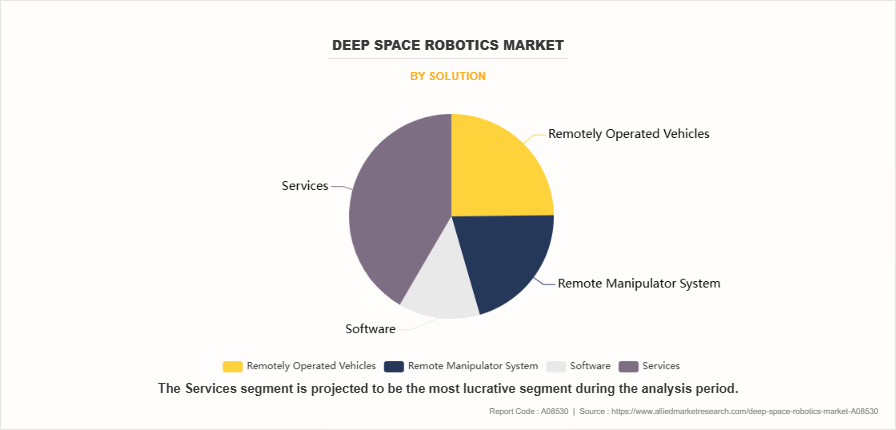
Based on solution, the services segment dominated the global Deep Space Robotics industry in the year 2023 and is likely to remain dominant during the Deep Space Robotics Market Forecast period. The dominance of the services segment in the deep space robotics market in 2023 is driven by the increasing demand for robotic maintenance, repair, and operational support for space missions. Space agencies and commercial entities are focusing on outsourcing robotic mission operations, system integration, and technical support to specialized service providers, reducing operational costs while ensuring mission success. The rising adoption of robotics-as-a-service (RaaS) in deep space exploration further contributes to the segment's growth.
By Application
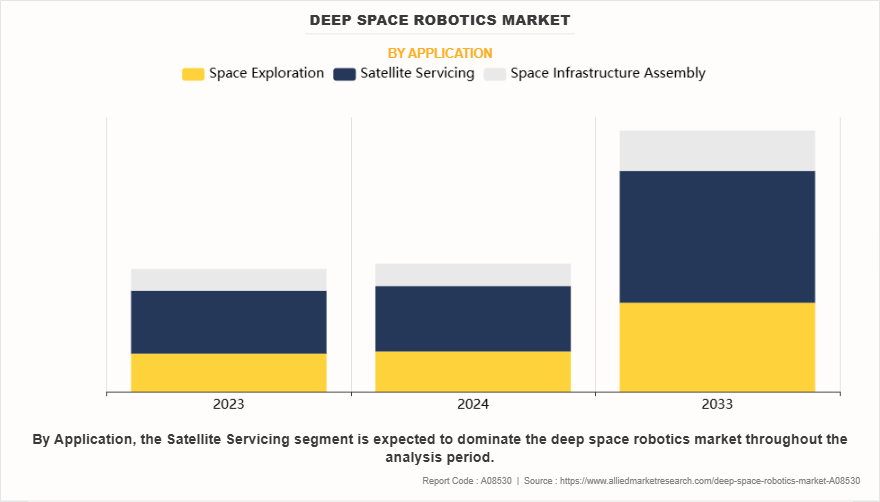
Based on application, the Satellite Servicing segment dominated the global Deep Space Robotics industry in the year 2023 and is likely to remain dominant during the forecast period. The satellite servicing segment has emerged as a key driver due to the growing need for extending the operational life of satellites, repairing malfunctioning units, and managing space debris. Advances in autonomous robotic systems enable in-orbit refueling, component replacements, and adjustments, reducing the costs of launching new satellites. Government initiatives and private sector investments in satellite sustainability and space traffic management are reinforcing the segment's expansion.
By End user
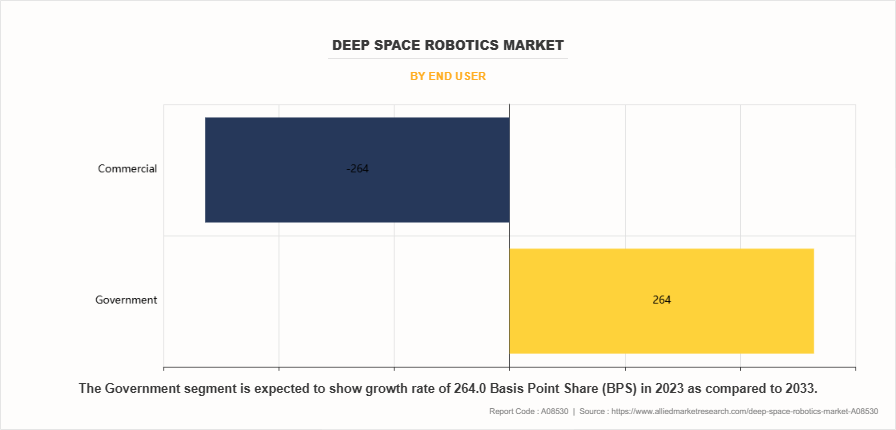
Based on end user, the government segment dominated the global market in the year 2023 and is likely to remain dominant during the forecast period. The government sector continues to lead the market as national space agencies, including NASA, ESA, Roscosmos, CNSA, and ISRO, are the primary investors in deep space missions. Governments allocate significant budgets for planetary exploration, space station maintenance, and interplanetary research, requiring advanced robotic technologies. The increased focus on space security, asteroid mining, and Mars exploration further strengthens government investments in deep space robotics.
By Region
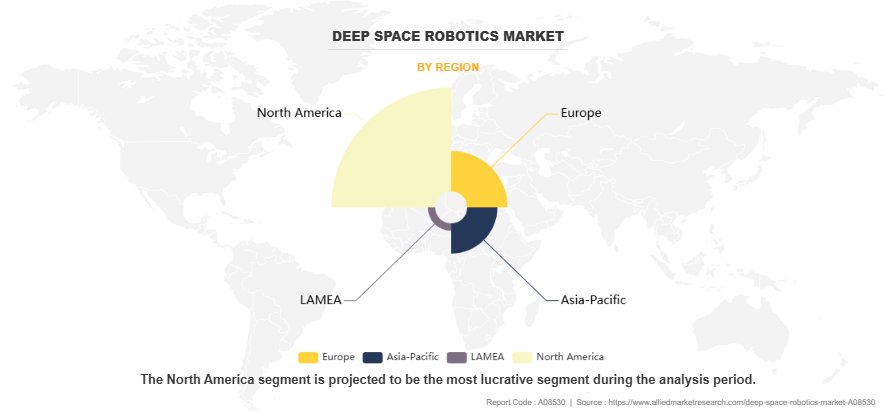
Based on region, North America dominated the global market in the year 2023 and is likely to remain dominant during the forecast period. North America dominated the deep space robotics market in 2023 due to its strong space exploration programs, advanced technological infrastructure, and high R&D investments. The presence of major space agencies like NASA and leading private space firms such as SpaceX, Blue Origin, and Lockheed Martin provides a competitive edge. Additionally, government support through policies, funding for deep space missions, and collaborations with commercial entities bolster North America's leadership in the market.
Competition Analysis
Companies have adopted product development and product launch as their key development strategies in the space robotics market. The key players operating in this market are Northrop Grumman Corporation, Altius Space, Effective Space Solutions Limited, Made in Space, iSpace, Honeybee Robotics, Motiv Space Systems Inc., Maxar Technologies, ASTROBOTIC, Space, Applications Services, Ceres Robotics, and Lunar Resources.
Key Benefits For Stakeholders
- This report provides a quantitative analysis of the market segments, current trends, estimations, and dynamics of the deep space robotics market analysis from 2023 to 2033 to identify the prevailing deep space robotics market opportunities.
- The market research is offered along with information related to key drivers, restraints, and opportunities.
- Porter's five forces analysis highlights the potency of buyers and suppliers to enable stakeholders make profit-oriented business decisions and strengthen their supplier-buyer network.
- In-depth analysis of the deep space robotics market segmentation assists to determine the prevailing market opportunities.
- Major countries in each region are mapped according to their revenue contribution to the global market.
- Market player positioning facilitates benchmarking and provides a clear understanding of the present position of the market players.
The report includes the analysis of the regional as well as global deep space robotics market trends, key players, market segments, application areas, and market growth strategies.
Deep Space Robotics Market Report Highlights
| Aspects | Details |
| Market Size By 2033 | USD 3329.1 million |
| Growth Rate | CAGR of 8.2% |
| Forecast period | 2023 - 2033 |
| Report Pages | 300 |
| By Solution |
|
| By Application |
|
| By End User |
|
| By Region |
|
| Key Market Players | iSpace Inc., Made In Space,Inc., Astrobotic Technology, Northrop Grumman, Honeybee Robotics, Ceres Robotics Inc., Motiv Space Systems Inc., Lunar Resources, Inc., Maxar Technologies, Space Applications Services |
Analyst Review
The deep space robotics industry is experiencing significant advancements driven by the escalating need for satellite maintenance and servicing. Satellites, operating in the harsh environment of space, are subjected to extreme temperatures, high radiation, and the vacuum of space, leading to frequent breakdowns and necessitating regular maintenance. This has spurred the development of robotic systems capable of performing complex tasks such as repairs, refueling, and extending the operational lifespan of satellites.
Global space agencies and private companies are increasingly investing in space robotics to enhance the sustainability and resilience of space operations. For instance, NASA identified several robotics sectors as vital components of its space technology roadmap for 2035, focusing on developing autonomous systems for satellite servicing and debris removal. Similarly, the European Space Agency (ESA) is collaborating with space robotics companies through initiatives such as the PERASPERA program, which aims to advance technologies for in-orbit servicing and assembly.
The integration of emerging technologies such as Artificial Intelligence (AI) and Deep Learning (DL) is revolutionizing the capabilities of space robots. AI-powered robots are developed to operate with minimal human intervention, enabling them to execute complex tasks over extended periods. These robots autonomously navigate, make real-time decisions, and adapt to unpredictable conditions in space, thereby enhancing the efficiency and safety of space missions.
Recent developments have led to the rapid progress in this field. In January 2025, the Indian Space Research Organisation (ISRO) achieved a significant milestone by successfully docking two satellites, demonstrating the feasibility of robotic servicing in space. This accomplishment highlights India's growing capabilities in space technology and its commitment to advancing space exploration.
Furthermore, the U.S. Naval Research Laboratory has developed a spaceflight-qualified robotics suite capable of servicing satellites in orbit. This technology is expected to play a crucial role in future satellite maintenance missions, offering solutions for on-orbit repairs and extending the operational life of satellites.
The convergence of AI, robotics, and space exploration is paving the way for more sustainable and efficient space operations. As these technologies continue to evolve, they are able to transform space exploration, making it more autonomous and resilient. The ongoing research and development in this domain are crucial for addressing the challenges of maintaining and servicing satellites, ensuring the longevity and functionality of space assets.
The global deep space robotics market was valued at $1,563,967.8 thousand in 2023, and is projected to reach $3,329,120.7 thousand by 2033, registering a CAGR of 8.2% from 2024 to 2033.
The report sample/ company profile section for deep space robotics market report can be obtained on demand from the website.
The key growth strategies adopted by the Market players includes innovations, merger, product launch, investemt, joint venture, partnership and business developments with the increased RnD expenditure.
Among the analyzed geographical regions, currently North America is dominating the market with the highest revenue in the global market. However, the same region is expected to grow at a higher rate during the forecast period, predicting lucrative opportunities .
Altius Space Machines, Astrobotic Technology, Honeybee Robotics, ispace Inc., Maxar Technologies
Loading Table Of Content...
Loading Research Methodology...


